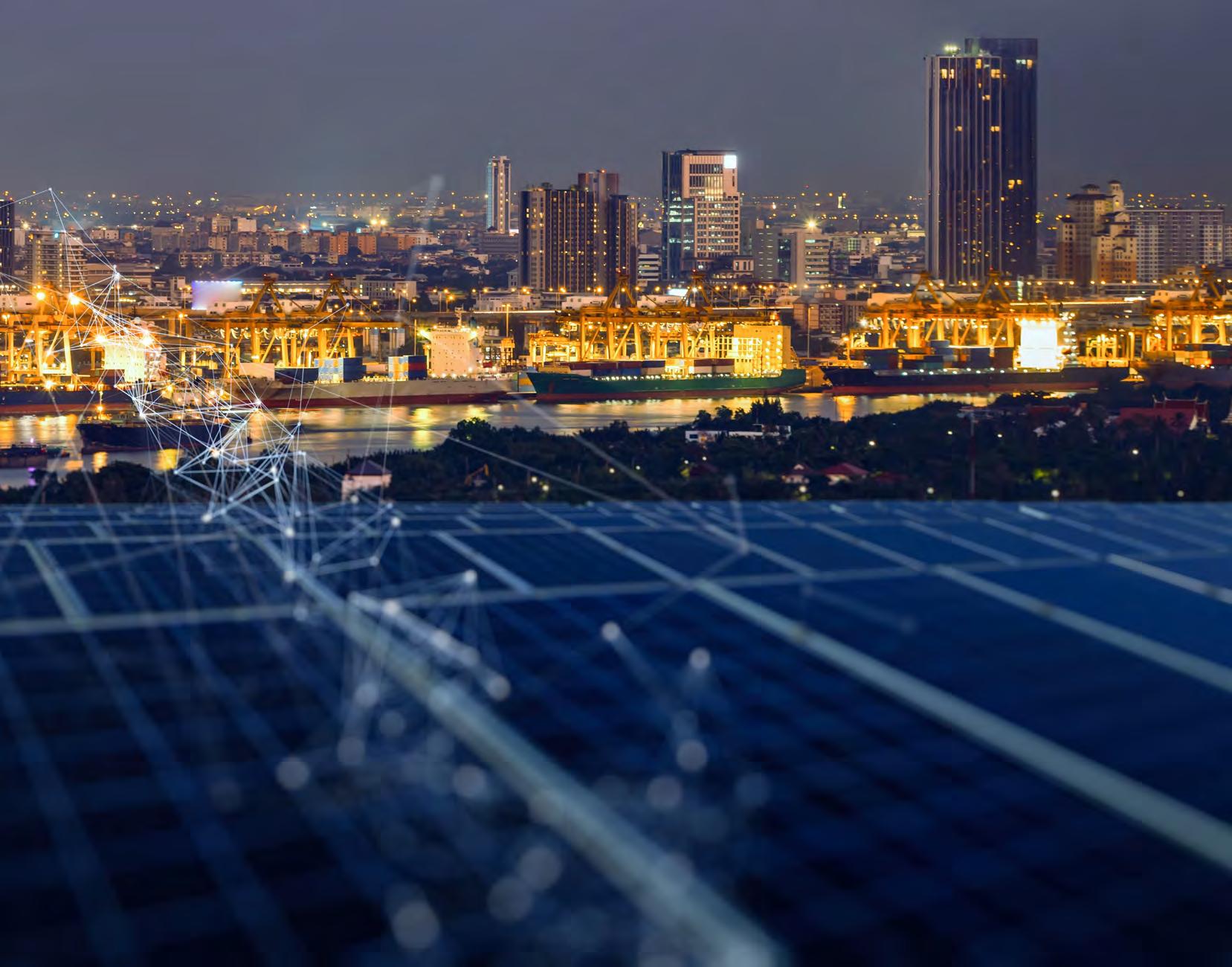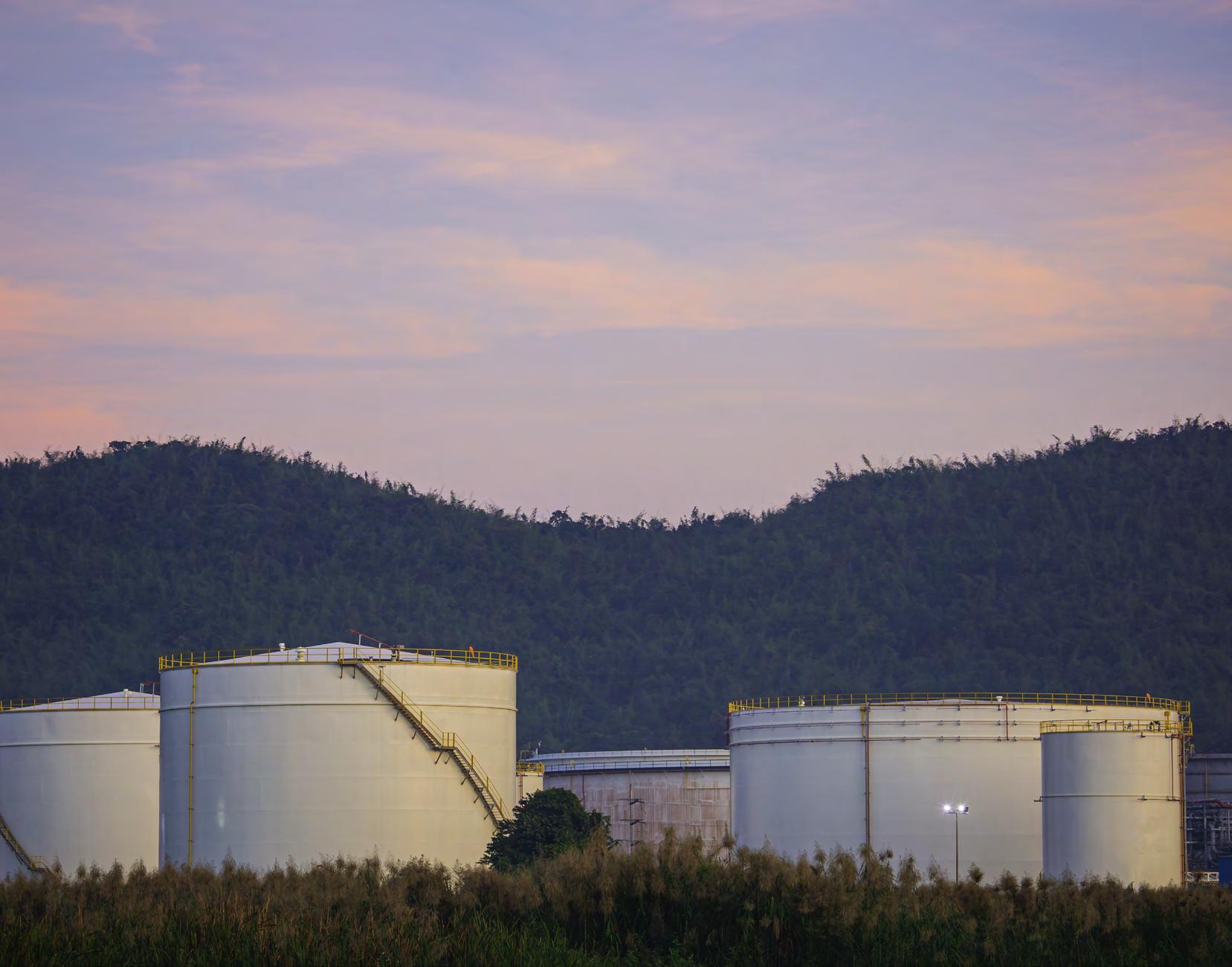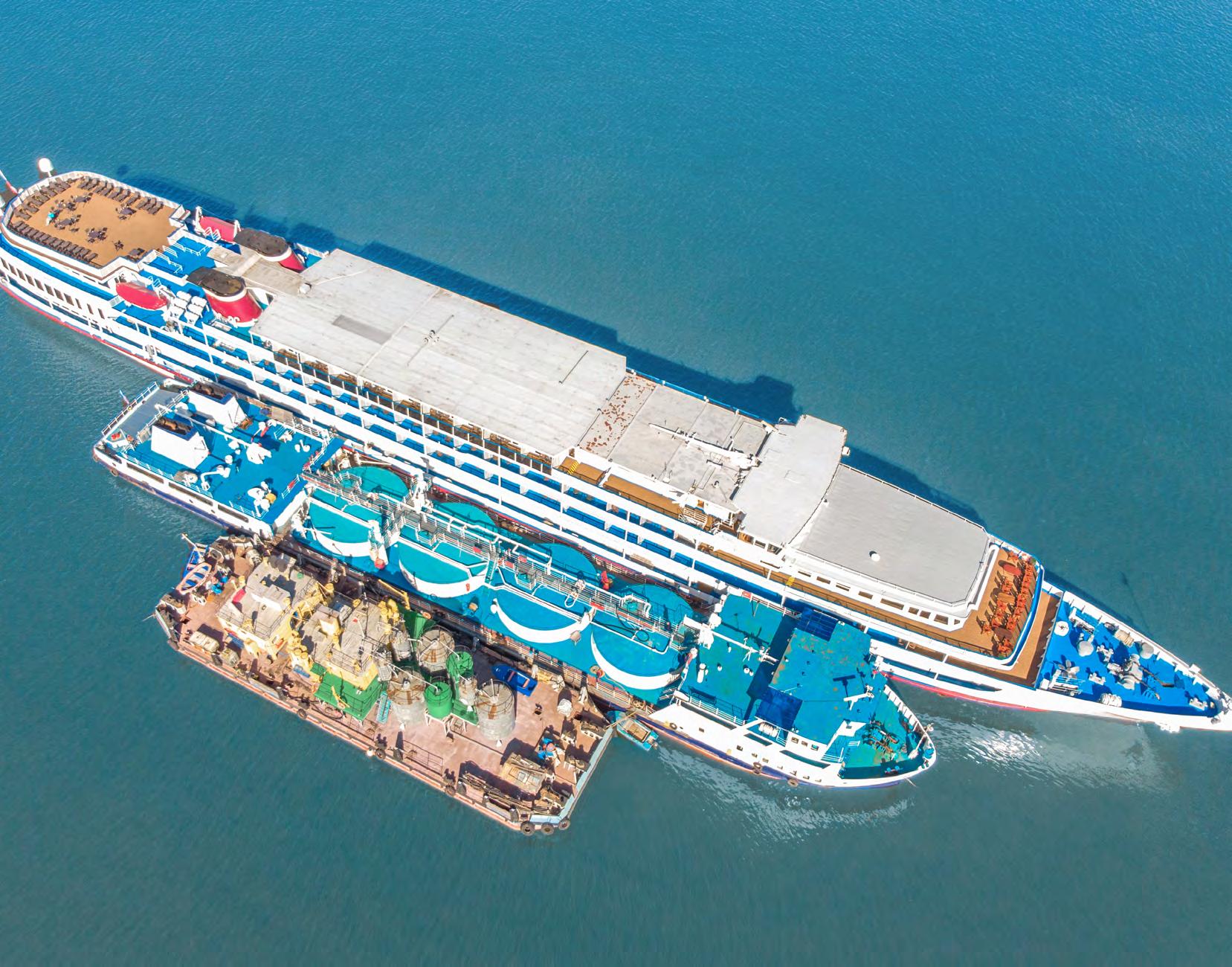
10 minute read
RENEWABLE ENERGY
from CSI Summer 2022
by Maritime-AMC
WINDS OF CHANGE
Using windpower is just one of the ways that companies are harnessing their resources to come up with eco-friendly solutions to existing power demands
New data released recently has revealed how the global shipping industry will require the equivalent of the world’s entire current renewable energy demand in order to replace fossil fuel use.
Fuelling the Fourth Propulsion Revolution by Stefan Ulreich from Germany’s University of Applied Sciences, and commissioned by the International Chamber of Shipping, highlights the enormous opportunity for investors and governments represented by the global shipping industry’s need for new, green fuels.
To reach the industry’s 2050 net- zero goal, shipping’s fuel needs would require electricity from renewable sources to increase by up to 3,000TWh, the report showed. This is the equivalent of the entire world’s current renewable energy production.
It found that to achieve the International Energy Agency’s net-zero emissions by 2050 scenario, the world would need an 18-fold increase in existing renewable production capacity.
Taking the global trading of hydrogen as an exemplar, the report identified substantial potential benefits for exporting and importing countries, particularly in the global south. This is due to the expected production cost differentials of such fuels across the world (expected range of €72.60/ MWh to €156.40/MWh in 2050).
The cost range reflects the abundance of renewable potential, such as solar and wind power, in many African and Latin American countries, which can generate the electricity needed in the production of hydrogen fuels at much lower cost.
The report identified the first movers who are looking to seize these investment opportunities, including Germany, Algeria, and Chile, who have signed multiple bilateral agreements on the production of hydrogen fuels (seen as key for powering ships).
Unveiled at the World Ports Conference in Vancouver, Canada, the report urgently calls for increased R&D in green fuels, and to specifically develop production infrastructure
in key geographic locations such as Latin America and Africa.
Estimates show a production potential of more than 10,000 TWh for net-zero carbon fuels in coastal regions worldwide. Shipping views investment in these areas as key to helping countries realise the potential gains present in their bilateral agreements.
Up to this point, there continues to be a lack of investment in zeroemission technologies, with the IEA highlighting that the total amount of corporate R&D investment for maritime has decreased, from $2.7bn in 2017 to $1.6bn in 2019.
Yet by 2050, at least half of net-zero fuels traded globally are expected to be moved by ships, according to the International Renewable Energy Agency. The report indicates that this makes maritime a key enabler of the decarbonisation of land-based industrial sectors.
Professor Ulreich comments: “To meet the enormous demand for hydrogen-based fuels in the global north, production centres in the global south are urgently needed.
“While governments are beginning to realise the need to transition to fuels like hydrogen, little thought to date seems to have been given to how they will actually transport those fuels.
“Shipping must be part of wider energy transition negotiations, and shipping and ports are going to need investment. But with this investment comes huge opportunity for return.”
Stuart Neil, director of strategy and communications at the International Chamber of Shipping adds: “Shipping will be a key enabler of the global energy transition, providing cost effective and flexible solutions to transport at least half of the net-zero carbon fuels traded around the world.
“A great deal is talked about the global energy transition to zeroemission fuels outside of shipping. But what we have found in this report is that there is a tremendous opportunity for all.” To download a copy of the report, visit: tinyurl.com/FourthPropulsion JOINT EFFORTS
Netherlands-based Econowind and Vertom have recently announced a collaborative project to install windassist VentiFoil units on multiple vessels by the end of this year. These will be retrofitted on the general cargo vessels Progress and Perfect, making it the first fleet order for Econowind.
Econowind will install the next generation VentiFoils on the vessels. The suction method has been upgraded, which results in limiting the number of moving parts. This next step by Vertom allows Econowind to further invest in production methods, making production faster.
Thomas van Meerkerk of Vertom says: “Vertom recognised the momentum for partnerships with a clear focus on decarbonising our business activities and supply chain. After considering the business case of the VentiFoil units, we are pleased to extend our collaboration with Econowind with an order for two vessels.”
Vertom has been studying wind assisted propulsion in more detail for their vessels since signing the contract for the retrofit of two VentiFoils on the Anna, which will be installed in June.
Vertom made the decision to invest in the VentiFoil, by also closely considering the following key variables: EEXI, Carbon Intensity Index for existing ships; CII, CO2 per nautical mile in operation; EEOI, emission per cargo.
Rolf van Leeuwen, senior technical superintendent of Vertom, says: “Installing the VentiFoils is a big step forward in reducing (CO2) emissions and fuel consumption for our current fleet. It is, along with our upcoming newbuilding program, a good step towards reducing our carbon footprint.”
Frank Nieuwenhuis, chief of Econowind adds: “We are delighted to make this next step in making shipping more sustainable together. The more installations we can retrofit, the more data we can attain and learn from. This provides us with solid proof of how wind-assisted ship propulsion is reducing emissions per nautical mile and improving vessels their EEXI / EEDI. This also serves as a justification for the investment – the costs of systems can be covered by the savings.” ODFJELL APPROVAL


Classification society DNV has awarded Odfjell Oceanwind Approval in Principle (AiP) for its new Deepsea Semi floating wind foundation design. The design has been developed for use in floating wind farms and for off-grid applications including temporary electrification of oil and gas installations in harsh environments.
The Deepsea Semi foundation is designed for wind turbine generators up to 15MW and has been developed for low cost, industrial massproduction. The design basis includes all areas for floating wind farms currently in planning in the North Atlantic region, including Scotwind and Utsira Nord, and covers a range of 601,300m water depth
“This AiP marks an important milestone for us,” says Per Lund, chief executive of Odfjell Oceanwind. “Building on the long-term relationship with DNV, we have chosen to work closely with them from day one in our development and will continue to do so for the class approval and certification of our fleet of Mobile Offshore Wind Units. The mindset from shipping that we share with DNV has proved to be valuable for us in creating a product and service for floating wind power that scales much faster than what we have seen in the industry before.”
“Several recent expert reports have highlighted how important it is to tackle the climate crisis today. As such, we need to be exploring solutions that can maximise the contribution of sustainable, zero carbon energy generation to the energy transition,” comments Erik Henriksen, director of business development - offshore classification at DNV. “Novel solutions
need the grounding of solid technical standards to build the trust that is essential for them to succeed in the market.”
The design has been developed for use in Odfjell Oceanwind’s fleet of Mobile Offshore Wind Units. Odfjell Oceanwind plans to order the first batch of units later in 2022, with a plan of going into operation in 2024. The units will be operated as one fleet under Odfjell Oceanwind’s management.
SUPER-SIZE SAIL
Classification society Bureau Veritas has provided Approval in Principle (AiP) to shipyard Chantiers de l’Atlantique for its sailing propulsion system, Solid Sail, tailored for the large ships market.
Solid Sail is a 1,200m² rigid sail made of composite panels assembled together, which was developed specifically for large vessels. The system overcomes the usual size limitations of standard fabric sails. Moreover, the rigidity of the sail panels induces less flapping and therefore increases the estimated life compared to a soft sail.
Increasing the energy efficiency of cruise ships and lowering their impact on the environment are two of the main objectives of Ecorizon®, Chantiers de l’Atlantique’s R&D pioneering 14-year old programme dedicated to ship energy and environmental efficiencies. The approval in principle step paves the way for the commercialisation of Solid Sail and its installation on large cruise ships.
Frédéric Grizaud, senior vice president at Chantiers de l’Atlantique, says: “The concept of Solid Sail is the first of its kind and is the most advanced and innovative solution of sailing propulsion of the large ships market. The integration on-board a passenger ship of such an innovative solution is only possible thanks to the tremendous collaborative work done with Bureau Veritas on its new rules on Wind Assisted Propulsion.”
Laurent Leblanc, senior vice president technical and operations at Bureau Veritas Marine & Offshore, comments: “The power of the wind, even if it is not always available, can make a significant contribution to greenhouse gas-free ship propulsion and ship design. We are pleased to deliver this AiP to Chantiers de l’Atlantique, bringing trust in wind propulsion systems and supporting the GHG emission reduction of shipping more generally. That’s how we can help shape a better maritime world. We look forward to seeing the system in operation.”
ROTOR SAIL FOR RO-ROS
Wind propulsion provider Norsepower Oy, recently announced an agreement signed with CLdN, the logistics specialist for road, sea and rail, to install two tilting rotor sails onboard a 2018-built ro-ro vessel. Preparations are currently taking place with the installation anticipated to be completed by December 2022.
The Delphine, a vessel with a cargo capacity of close to 8,000 lane meters, transits between the UK, Ireland and Europe and is the largest short sea ro-ro vessel operating in the world today. With two 35mx5m rotor sails, Norsepower has estimated that the technology would achieve a fuel and emission reduction saving of between 7 to 10% for this vessel, depending on the route.
The Norsepower rotor sail solution – which can be installed on new vessels or retrofitted on existing ships – is a modernised version of the Flettner rotor, a spinning cylinder that uses the magnus effect to harness wind power to thrust a ship. At the time the contract was signed, this was the seventh vessel to be installed with Norsepower’s rotor sails.
Tuomas Riski, chief executive of Norsepower, says: “Seeing the interest grow in our tilting rotor sail design demonstrates how the industry is looking for proven, flexible solutions to lower carbon emissions and reduce fuel costs across a range of vessel sizes and operations.
“Norsepower’s rotor sail installation on the Delphine demonstrates how the use of clean technology can modernise and evolve the performance of fleets’ younger vessels to manage emissions and help to increase asset value. With fuel becoming increasingly expensive, making savings will also have a huge impact on commercial success. Working with CLdN and its ambitious team is an opportunity to demonstrate what our technology has to offer to continue strengthening the environmental and commercial performance of its fleet.”
Gary Walker, COO Shipping at CLdN, adds: “ This demand for cleaner shipping is growing and we are committed to making measurable progress. Installing two of Norsepower’s rotor sails will maximise our fuel and emissions savings on the MV Delphine, and this pilot project will help determine how the rotor sail technology could be rolled out on the current CLdN fleet and our newbuild vessels. We look forward to the installation and subsequent results.”
The company claims the Norsepower rotor sail is the first third-party verified and commercially operational auxiliary wind propulsion technology for the global maritime industry. Norsepower adds that the solution is fully automated and detects whenever the wind is strong enough to deliver fuel and emission savings, at which point the rotor sails start automatically.











